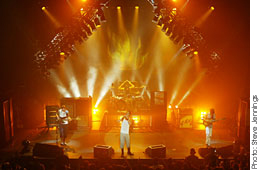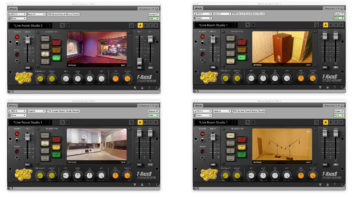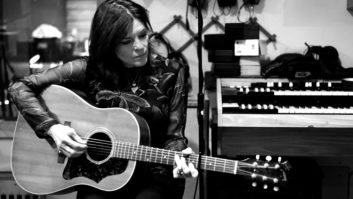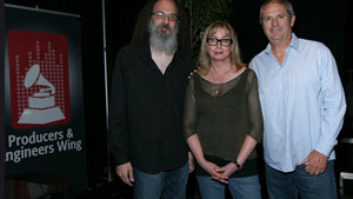
Once considered the property of ’70s rock history, the concept ofthe “supergroup” is once again alive and well. Comprisingthe remaining members of Rage Against the Machine and Soundgarden’sChris Cornell, Audioslave took to the road last winter in support oftheir eponymous debut release. Widely known for their radical politicalviews, it seemed almost too perfect that the band sold out two nightsat San Francisco’s Warfield Theatre amidst a climate of antiwarprotests and sentiment that had gained national attention. Armed withtwo certified radio hits, the lead-off single “Cochese” andits follow-up “Like a Stone,” the band performed extendedsets for two already-frenzied and anxious crowds.

FOH engineer Greg Price, a longtime fixture in the Ozzy Osbournecamp, mixes from a Yamaha PM4000 console. “It’s aworkhorse,” Price explains. “I’ve got the support act onthe same console, and it’s very user-friendly. This is, of course, aclub and theater tour: I couldn’t fit a bigger board into some of theseplaces.
“This band is so simple,” he adds. “It’s reallydrums, guitar, bass and vocals. If you took out all of the extra stuff,you could practically mix this band on six channels. With the radioshows we were doing, you don’t get a soundcheck and it’s allon-the-fly. With just a kick, snare, two overheads, one bass and oneguitar channel, and one vocal channel, I had sound pretty quick. I’vegot 24 inputs and nothing really fancy. The drums are straight-ahead: Ilike to use the Shure SM 91/Beyerdynamic M-88 kick-drum combination.The bass guitar is six channels because [Tim Commerford, bassist] hasthree separate bass systems up there. And the guitar is two channels,left and right, which allows me to get great separation.”
The remaining stage mics and inputs include a Shure SM 57 on snaretop, Audio-Technica 4041 on snare bottom, A-T 4041 on the hi-hat, A-T3000s on toms, A-T 4050 overheads, A-T 4050 on guitar, A-T 4040 on basschannel one and A-T M25s on bass channels two and three. Chris Cornellsings through a Shure SM 58 wireless. Additional outboard processorsinclude two TC M3000s, a TC 2290 and an Eventide H3000 for occasionalpitching and doubling chores.

Audioslave’s monitor engineer, known only as J.W., mixes bothtraditional and in-ear monitors from a Yamaha PM4000. Onstageenclosures consist of ShowCo ML-18 sidefills, 1215 wedges, B1 subs andSRM cabinets. Chris Cornell uses a single in-ear monitor fed from aShure PSM 600 wireless system. Stage inputs include 12 channels ofdrums, three bass DI lines, three bass-cabinet mics, two guitar micsand one vocal channel.
“Chris just gets his vocal in his ear and just his vocal inhis wedges,” systems tech Scott Frey explains. “As far assidefills, it’s pretty bass heavy, but there is guitar and vocals anddrums everywhere. Stage left, Tom [Morello’s] side isn’t really thatloud, but it’s a drums, guitars, bass and vocal mix pretty mucheverywhere. And the drummer has thumpers under his seat; it’s prettyrockin’ up there. All in all, it’s pretty basic up there. Juststraight-ahead rock ‘n’ roll.”



